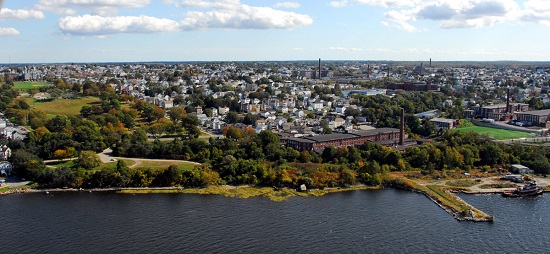By JOYCE ROWLEY, for ecoRI News
NEW BEDFORD
“We're forging ahead,” Jean Fox, the Massachusetts Bay Transportation Authority's project manager, told the South Coast Rail Task Force at its Feb. 25 meeting, when questioned whether the change in administration would affect the South Coast Rail. “We’ve got our marching orders and we’ve not been told otherwise.”
The 20-year-old South Coast Rail (SCR), now in its preliminary design stage, has chugged along despite a protracted planning and environmental review. Last summer, the Massachusetts Bay Transportation Authority (#mbta) awarded a $12 million preliminary design contract to the engineering firm Vanasse Hangen Brustlin, with an option for a $210 million 10-year final design and construction contract.
“It’s pretty exciting. The goal was to get approximately 15 percent design completed by June 30, 2015,” Fox said. “We’re on target for #most tasks.”
In January 2014, the U.S. Army Corps of Engineers issued a final environmental impact statement for an electric train line that will extend the existing MBTA Stoughton commuter rail line. Passing through the 2,000-acre Hockomock Swamp on an abandoned rail bed to #taunton, the new branch will split in Berkley. The main line will connect to New Bedford on existing freight tracks, and a branch will continue to Fall River.
But record snowfall beginning with the first storm on Jan. 26-27 left the T demobilized throughout Greater Boston, leaving some at the meeting questioning the viability of the project.
“Is the state thinking of spending $3 billion on a new line when the T hasn’t worked well for a month?” asked Kyla Bennett, director of Public Employees for Environmental Responsibility.
Fox said that $2.3 billion was allocated in the state transportation bond last year to build the SCR. Fox said they would be meeting with Gov. Charlie Baker’s administration about the project soon.
“Our goal is to sit down with them and see where we fit in," Fox said. “It’s a transportation priority and has been for several years. We can show a cost-benefit analysis of the transportation, environmental and economic development potential for the project.”
Blame for the T’s winter problems has been laid at the 9 feet of snow that incapacitated commuter lines to Worcester, Springfield, Lakeville and Stoughton; at the use of T parking lots by residents who had to stay off the streets during parking bans which then left T commuters with no place to park; on outdated equipment on some lines that couldn’t make it through deep snow.
Now, over a month later, all commuter rail lines are still on revised schedules. It remains to be seen whether promises to get the entire system in order by March 30 can be met.
In a interview with ecoRI News later, Bennett questioned the allocated amount of funding, as well as the wisdom of spending billions of dollars on a rail line that may not be used.
“I think the $2.3 billion is a vast underestimate,” she said. “Public records requests to get the most recent cost estimate were denied.”
Her group won on appeal to the state, but then only received the estimate with minor modifications. The estimate hasn’t changed much since the 2011 draft, Bennett said.
“I don’t know how much it will cost to fix the T, let alone what it will cost to do both,” she said. “The reason this matters is because if it is more, then that’s even more that we won’t put into fixing existing infrastructure.”
Transportation justice
SCR Task Force Chairwoman Susan Teal disagrees. The Rochester resident said both maintenance of the existing lines and development of the new branch are needed.
“There's plenty of money for both,” Teal said at the recent meeting.
All other major cities in Massachusetts tie into Boston via rail, except Taunton, New Bedford and Fall River. All three are “Gateway Cities” and all three have consistently pushed for the connection.
Most proponents of the rail expect it will make a connection to Boston and jobs, but will also help draw businesses to the region. In fact, regional planning agencies the Southeast Regional Planning and Economic Development District, Metropolitan Area Planning Council and the Old Colony Regional Planning Council show anticipated growth in surrounding communities.
“Just look north to Lowell to see what rail does for a community,” Fox said. “It brings in higher-paying high-skilled jobs and builds new housing stock.”
Nearly $2 million in technical assistance grants to 31 communities over the past seven years has promoted the SCR’s “Smart Growth” planning efforts to mitigate potential impacts in advance. In fiscal 2015, the MBTA spent $353,830 on technical assistance to communities under SCR’s program.
Smart growth is a buzz-phrase for planning to minimize sprawl and reduce vehicle trips, and resulting greenhouse-gas emissions. It includes building transit-oriented development that reduces the need for additional highway infrastructure.
“Smart growth has been impactful and productive,” Fox said.
Bennett questioned the anticipated greenhouse gas-reduction benefits that the SCR may create. Instead, she said the money would be better spent creating jobs in the three targeted cities so people could work where they live.
“People are going to pay $500 to $600 per month to travel four hours on a train for what jobs in Boston?” Bennett said later. “Taking cars off the highway even if there is ridership won’t necessarily make a difference. Cars backfill in the highway when people realize there’s more room.”
Next month, the MBTA will begin construction of independent utilities, including grade crossings and a rail bridge at Wamsutta Street that will serve active freight. These components of the project need to be built even if the SCR isn't completed, according to Fox.
















